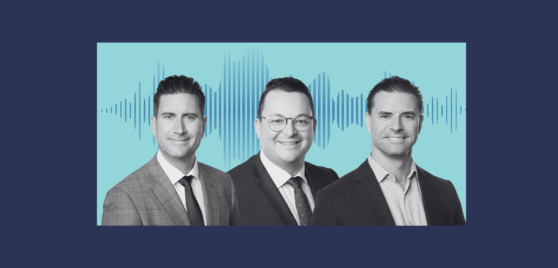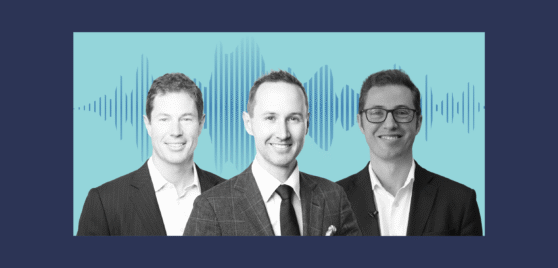Featuring Hugh Giddy & Daniel Moore
LISTEN
READ
Portfolio managers Hugh Giddy and Daniel Moore discuss what happened in markets in the June quarter as well as the performance of IML’s large cap funds and key stocks over financial year 2025.
Follow our podcast, ‘Navigating the Noise’ on Spotify, Apple or Amazon to be notified of new episodes.
 |
 |
 |
Lightly edited transcript – Recorded on 8 July
Jason Guthrie: Hello and welcome to Navigating the Noise, a podcast by Natixis Investment Managers, where we bring you insights from our global collective of experts to help you make better investment decisions. I’m Jason, and today I’m joined by IML Portfolio Managers Hugh Giddy and Daniel Moore. Now, Hugh and Dan have been co-managing the large cap funds at IML for over 10 years. They’ve built a great partnership together, and today we’re going to discuss what’s happened in markets over the last quarter, how the funds have performed, some of the better holdings in the portfolios, and the outlook from here. Please enjoy the conversation.
Hugh and Dan, double trouble today. Welcome back to the podcast. It’s great to have you.
Hugh and Daniel: Thanks, Jase.
Jason: So, we had a pretty bumpy start to the quarter in April with Trump tariffs and the war in Iran, but it’s been an incredible rebound into the end of the financial year. The ASX 300, I think, was up around 9% for the quarter alone. What were the key drivers of this standout result from the largest companies here in Australia?
Hugh: As you mentioned, Jase, the tariffs were threatened but gradually reduced or renegotiated for many countries, with tariffs still threatened to come in in August. The phrase “TACO” has entered the media, meaning Trump Always Chickens Out because what he threatened he hasn’t followed through on. Markets obviously rallied when the threat of tariffs, which could cause an economic slowdown, seemed to diminish.
Markets also seem to believe that inflation is not a big issue anymore, but given the high level of government spending — not only in Australia but in the US, where the big beautiful bill has been passed — suggests that inflation remains a risk, although the markets don’t seem to be terribly worried about that.
I would note the Reserve Bank has held interest rates today as we record this podcast, which does indicate they can see there is a danger of inflation picking up again. The other thing, as you mentioned, there have been geopolitical issues such as the strikes on Iran. We’ve had Chinese warships circling Australia and so on, but in general, the market has shrugged those things off, producing a strong quarter globally and in Australia.
Jason: And looking at the full financial year, I know the flagship Australian Share Fund was slightly ahead of the benchmark, which was up around 14%. So, great work, I know it’s been a pretty challenging period for a lot of the Australian-based managers with the run that we’ve seen from the banks in particular. What were some of the key events across the full financial year to point out in regards to that performance?
Daniel: Yeah, Jase, if we look at the sector breakdown, it really was the banks and financials that drove a good chunk of the returns. That sector was up 29% for the year, which you can’t really point to any exact events that drove that. I mean, earnings for the sector were essentially flat, which has been well discussed. Quite remarkable is all we can say. Being underweight that sector has definitely been a headwind for the funds.
Jason: And are you seeing, Dan, are you seeing this weight of money coming from offshore? I keep hearing that there’s demand from offshore funds as people repatriate money or move money out of the US market for those large bank stocks.
Daniel: Yeah, we are hearing money has been moving away from the US. When it does go elsewhere in the world, Australia is seen as a relative safe haven or a good place to invest, given the strong dynamics of our economy with population growth and a population that’s not aging or declining like many other parts of the world.
The Australian banks make up a big part of our index. So when they invest in Australia, the banks do attract a lot of flows. On the flip side, particularly with CBA, retail makes up a large part of the register. In the lead-up, particularly towards the end of the financial year, people didn’t want to sell CBA because the capital gains would have been significant. So, you didn’t have a lot of sellers, and you had incremental buying, which led to the significant price rises in the bank stocks.
Jason: Maybe moving on to some of the key individual companies in the funds, you did have some great performers, obviously helping with that 12-month number. I think Brambles was at the top of the charts there and also the ASX 20’s top-performing stock for the year. Do you actually see further upside in Brambles? I know it’s been a long-term holding, but have you been trading around the current price, or do you think it’s pretty full today?
Daniel: Yeah, we have trimmed some of our position. It’s fair to say we thought Brambles was a very high-quality business that was extremely undervalued given the returns it makes. It’s a global leader in its field. The past has been impacted by poor management, and when they changed the board and the executive team about five years ago, we’ve seen a dramatic improvement in the performance of the business.
Despite good results for many years now, it sort of feels like the market’s finally giving them credit. We saw the share price up 66% just in this year alone. When we look at Brambles, there’s no doubt the upside is not there like it was 12 months ago, but when we compare the value of Brambles to many of its peers in the Aussie marketplace, its relative value still looks pretty good. So we still own the business but have trimmed the position slightly.
Jason: Now, CSL is another cornerstone of the portfolios and has been for some time. It’s been a very successful ride there, but it has been a more disappointing year. What’s your sense of the company today, and where to from here?
Daniel: Yeah, look, it has been a disappointing year. They’ve had a few headwinds. Potential pharma tariffs have put some pressure on the stock, and potential drug price reforms have also been threatened by Trump. The flu sales in the US have also been a bit soft, and all these things have led to the company de-rating significantly despite delivering some decent earnings growth.
Today, you can buy the stock on a price-to-earnings multiple of around 21 to 22 times, which is the lowest it’s been in many, many years. We think the outlook from here is very strong. We think the company’s going to deliver double-digit earnings growth for the next three to five years because their core business is performing really well, and we think it’s quite likely the impact from pharma tariffs, drug price reforms, and weak flu sales on the business won’t be as significant as the market thinks.
We believe CSL will be able to manage those things, and once those uncertainties are past — which should be in the coming months — we think the company has a good chance to re-rate substantially.
Jason: Fantastic. Have there been any recent changes over the quarter? Have you been, I know you mentioned you’ve been taking some profits on Brambles in particular, but any new positions that you guys are excited about?
Hugh: Sure, Jase. We have been trimming Brambles, and the banks, with their, you could say, unwarranted appreciation given the lack of earnings growth relative to most other companies in our portfolio. Telstra’s done very well; it’s been a holding for a while, and what we expected to happen — more rational mobile pricing — has played out.
We’ve trimmed Viva Energy, the refiner and convenience store operator. I think management let us down there and hasn’t managed the loss of tobacco sales very well.
We switched some of our Aurizon — which has had some challenges, some due to weather and perhaps some bad investment decisions — into a new holding in Dalrymple Bay, which is a coal export terminal near Mackay. It’s a very steady business with strong contracts with the coal miners and a good yield.
Jason: The other one I was going to ask about when I was looking at portfolios earlier was TechnologyOne. I know it’s only been a relatively small holding, but it has been a standout for the team. How are you positioning things there, Hugh?
Hugh: It’s fair to say TechnologyOne has been held for a very long time and has done well over time, but it seems to have really been appreciated by the market more recently. It’s delivered stellar results for a long time, but more recently, it has become a very high recurring earnings software business based out of Brisbane.
They sell software primarily to local councils and educational institutions. About 10 years ago, or longer, maybe 15 years ago, they entered the UK, which is obviously a very large market — double the size of Australia or more — and they are starting to really get traction in the UK. The market has obviously noticed that, leading to some strong price gains for the company.
That success in the UK means there’s a lot of runway left for them. Although the stock doesn’t look optically that cheap, we think the company is going to continue to do well, so it remains a holding for us.
Jason: All right. Well, we might wrap it up there, guys. Thank you, Hugh. Thank you, Dan, for your time today. Always a pleasure, and we do appreciate the update as we roll through 30 June and into reporting season. Thank you to all our listeners for joining in today. If you did enjoy the episode, please click follow on your favourite podcast platform and tune in again to hear more from our global collective of experts.
This podcast has been prepared and distributed by Natixis Investment Managers Australia Proprietary Limited, ABN 60 088 786 289, AFSL 246830 and includes information provided by third parties, including Investors Mutual Limited (“IML”) AFSL 229988, the responsible entity and investment manager for the IML Funds.
Although Natixis Investment Managers Australia believes that the material in this podcast is correct, no warranty of accuracy, reliability, or completeness is given, including for information provided by third parties except for liability under statute which cannot be excluded. This material is not personal advice. The material is for general information only and does not take into account your personal objectives, financial situation or needs. You should consider and consult with your professional advisor whether the information is suitable for your circumstances. The opinions expressed in the materials are those are the speakers and may not necessarily be those of Natixis Investment Managers Australia or its affiliate investment managers. Before deciding to acquire or continue to hold an investment in a fund, you should consider the information contained in the product disclosure statement in conjunction with the target market determination, TMD, available at www.stg-imlimited-staging.kinsta.cloud.
Past investment performance is not a reliable indicator of future investment performance and no guarantee of performance, return of capital, or a particular rate of return is provided. Any mention of specific company names, securities or asset classes is strictly for informational purposes only and should not be taken as a recommendation to buy, hold, or sell. Any commentary about specific securities is within the context of the investment strategy for the given portfolio. The material may not be reproduced, distributed, or published in whole or in part without the prior written consent of Natixis Investment Managers Australia.
Copyright 2025 Natixis investment Managers Australia. All rights reserved.
INVESTMENT INSIGHTS & PERFORMANCE UPDATES
Subscribe to receive IML’s regular performance updates, invitations to webinars as well as regular insights from IML’s investment team, featured in the Natixis Investment Managers Expert Collective newsletter.
IML marketing in Australia is distributed by Natixis Investment Managers, a related entity. Your subscriber details are being collected by Natixis Investment Managers Australia, on behalf of IML. Please refer to our Privacy Policy. Natixis Investment Managers Australia Pty Limited (ABN 60 088 786 289) (AFSL No. 246830) is authorised to provide financial services to wholesale clients and to provide only general financial product advice to retail clients.





